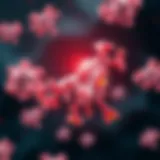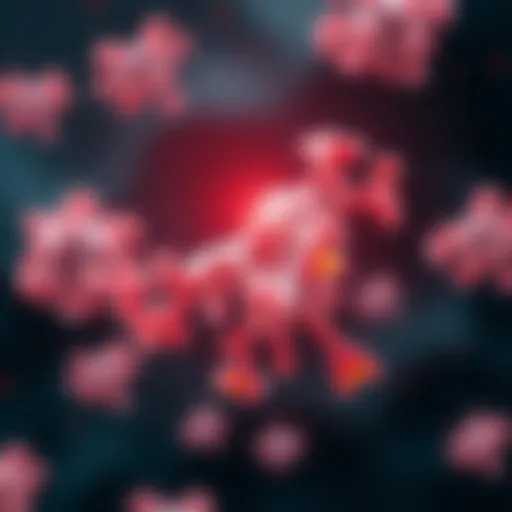Understanding Nectar: Composition & Ecological Roles
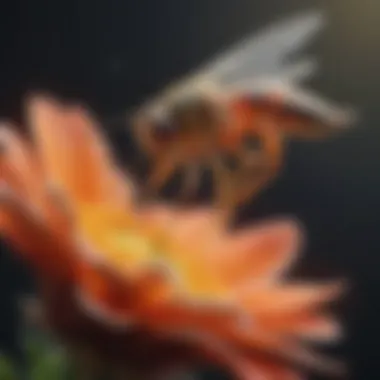

Intro
Nectar is a complex, often overlooked substance produced by flowering plants. It serves not just as a food source for various organisms but plays a crucial role in the health and sustainability of ecosystems. The sweet, syrupy fluid is composed primarily of sugars, water, and various organic compounds. This article aims to unpack the intricate layers of nectar, highlighting its biochemical composition, ecological significance, and implications for biodiversity and agricultural practices.
This exploration of nectar includes a detailed analysis of its interactions with pollinators, which are vital for the reproductive success of many plants. The relationships formed through nectar provision are essential for understanding the broader implications of plant-pollinator co-evolution. Additionally, this article emphasizes the importance of studying nectar to improve agricultural outcomes and support conservation efforts.
In essence, this narrative is positioned to shed light on nectar's various facets, offering insights that can benefit students, researchers, educators, and professionals alike. Understanding nectar is not only relevant for biological studies but also for practical applications in ecology and agriculture.
Research Overview
Summary of Key Findings
The investigation into nectar has revealed several key findings:
- Composition: Nectar typically consists of approximately 10-40% sugars, primarily sucrose, glucose, and fructose. This high sugar content makes nectar a vital energy source for pollinators.
- Ecological Roles: Nectar is crucial for attracting and sustaining pollinator populations. Each plant species may produce nectar with distinct properties, influencing the types of pollinators it attracts.
- Biodiversity: The interactions between nectar-producing plants and their pollinators contribute significantly to ecological diversity and plant reproduction.
Importance of the Research
Understanding nectar is fundamental to grasping ecological relationships and the mechanics of pollination. The research underscores how nectar influences not only individual plant species but also entire ecosystems. Its role in supporting pollinator populations can impact plant community structure, genetic diversity, and even food production systems. With the current decline in pollinator numbers globally, studying nectar is more pertinent than ever.
Methodology
Study Design
The studies on nectar often employ observational methods combined with experimental designs. Research can include field experiments and controlled lab studies to examine nectar composition and its attraction capabilities.
Data Collection Techniques
Researchers typically collect data through various techniques, such as:
- Direct observation of pollinator behavior relative to nectar availability.
- Chemical analysis of nectar samples to determine sugar content and other constituents.
- Surveys of plant-pollinator interactions to evaluate ecological impacts.
By employing these methods, scientists can gain a comprehensive understanding of nectar's role in ecosystems and its broader implications for biodiversity.
Prologue to Nectar
Nectar serves as a focal point in understanding various ecological processes. This sugary fluid produced by flowers is essential for not only plant reproduction but also for the survival of a myriad of species, especially pollinators. The significance of nectar extends beyond its sweetness; it is a complex substance that plays various roles in the ecosystem. Its composition and characteristics attract a wide range of pollinators, which in turn influences plant breeding systems and community structures.
A close examination of nectar reveals insights into the intricate relationships between plants and pollinators. These interactions are fundamental to many ecosystems. Furthermore, understanding nectar can inform agricultural practices, enhancing crop yields and promoting biodiversity. This section will introduce the concept of nectar, laying the groundwork for exploring its various aspects throughout the article.
Definition of Nectar
Nectar is a viscous fluid secreted by specialized glands in flowering plants. It is primarily composed of sugars, water, amino acids, and various nutrients. The main purpose of nectar is to attract pollinators such as bees, butterflies, and birds. These organisms, drawn by the sweet taste and the energy provided by nectar, play a crucial role in the pollination process.
Beyond attracting pollinators, nectar can also serve as a food source for other organisms, such as ants and various insects. Its composition can vary significantly among plant species and can even differ within the same species depending on environmental conditions. This variability is an important factor in ecological interactions.
Historical Perspectives
Historically, the study of nectar has evolved alongside the broader field of botany and ecology. Ancient civilizations recognized the importance of nectar for sustaining bees and other insects. They observed how certain plants flourished due to insect activity, although the underlying scientific principles were not fully understood.
In the 19th century, significant advances were made in the understanding of nectar’s role in pollination. Pioneering studies illustrated how nectar attracts specific pollinators, leading to an increased interest in plant reproduction and co-evolution. This perspective laid the groundwork for modern research, which integrates molecular biology and ecology to uncover the complexities of nectar production and its implications in ecosystems.
Recent studies have unveiled the biochemical complexity of nectar, leading to better understanding of how it influences not only pollinator behavior but also plant evolution. As science progresses, nectar is being appreciated not just as a plant product, but as a crucial component of biodiversity and ecosystem functionality. Thus, nectar’s historical context offers valuable insights into its current ecological significance.
Biochemical Composition of Nectar
Understanding the biochemical composition of nectar is essential for exploring its broader ecological implications. Nectar is not merely a sweet liquid; it is a complex mixture that serves various purposes in the ecosystem, especially in pollinator attraction and plant reproduction. Examining its components sheds light on how nectar supports both flora and fauna, which in turn influences biodiversity. Each element in nectar plays a role, impacting plant-pollinator interactions and ultimately agricultural practices.
Sugars and Their Types
The primary component of nectar is sugar. Nectar typically contains a variety of sugars, such as sucrose, glucose, and fructose. The ratio of these sugars can vary significantly depending on the species of the plant. For example, the nectar produced by some flowering plants, like honeybees' favored flowers, tends to be high in fructose and glucose, which are easily assimilated by pollinators.
- Sucrose is often the main sugar found in nectar of many plant species. It is crucial for energy and contributes significantly to nectar's sweetness.
- Fructose is another important sugar that attracts pollinators like butterflies and hummingbirds.
- Glucose, being a simple sugar, is vital for immediate energy but is less common in nectar than sucrose.
These sugars not only serve as energy sources for pollinators but also influence which species are attracted to specific flowers, thereby affecting plant reproductive success.
Presence of Amino Acids


In addition to sugars, nectar also contains amino acids. These compounds are paramount to both plants and pollinators. Amino acids serve as building blocks of proteins, crucial for growth and development. They play a role in pollinator attraction, as certain species are drawn to nectar with specific amino acid profiles.
Research has shown that the amino acid content in nectar can vary widely. For instance, some studies suggest that flowers offering higher concentrations of amino acids attract more pollinators. Key amino acids found in nectar include:
- Proline, often noted for its role in nectar quality and buoyancy.
- Glutamic acid, which has implications in signaling pathways for plants.
This amino acid content can enhance the nutritional value of nectar, making it a more attractive food source for various pollinators. Thus, the presence of amino acids in nectar contributes significantly to the ecological network.
Micronutrients and Secondary Metabolites
Beyond sugars and amino acids, nectar also contains micronutrients and secondary metabolites that add to its complexity. Micronutrients include essential minerals like calcium, magnesium, and potassium, which may not be present in high amounts but play vital roles in plant health and development.
Secondary metabolites such as flavonoids and terpenoids can also be found in nectar. These compounds may serve multiple functions:
- They can deter herbivores, protecting the plant against predation.
- They may also enhance the attraction of certain pollinators due to their scents or colors.
"Nectar's composition is a finely tuned balance of sugars, amino acids, micronutrients, and secondary metabolites that supports ecological interactions and influences evolutionary trajectories."
Understanding the intricate biochemical composition of nectar is fundamental. It provides insights into the interactions between plants and their pollinators, shaping biodiversity and agricultural practices. Thus, continuing research in this area is vital for grasping the full implications of nectar in nature.
Ecological Roles of Nectar
Nectar plays a crucial role in ecosystems, serving as a primary food resource for numerous species. This sugary fluid produced by many flowering plants is not just about attracting pollinators; it has intricate relationships with various aspects of ecological balance. The ecological roles of nectar can heavily influence plant and animal interactions and maintain biodiversity.
Nectar as a Pollinator Attractant
One of the primary ecological roles of nectar is its function as a pollinator attractant. Different plants produce specific nectar compositions, which influence the type of pollinators they attract. For example, some species might produce higher sugar concentrations to attract hummingbirds, while others might attract insects like bees or butterflies with floral scents. This targeted attraction is fundamental for successful pollination, which is vital for plant reproduction. Without pollination, many flowering plants cannot produce seeds or fruits, thus affecting their population and distribution.
Influence on Plant Reproductive Success
Nectar also significantly impacts plant reproductive success. The quality and quantity of nectar available can attract more pollinators, resulting in better pollination outcomes. A plant that efficiently produces nectar may see increased visits from pollinators, resulting in a higher chance of cross-pollination. Cross-pollination is important, as it promotes genetic diversity, which can improve a plant's resilience to diseases and environmental changes. Therefore, the production of nectar not just facilitates reproduction but enhances the overall health and adaptability of plant species.
Support for Other Fauna
Beyond its role in pollination, nectar serves as a food source for various non-pollinating fauna. Many nectarivorous animals, including some species of bats, birds, and insects, rely on nectar as a primary food source. These animals, while not directly involved in the plant's reproductive processes, contribute to the ecosystem's health by assisting in pollen transfer, albeit often unintentionally. Additionally, nectar can attract a range of other wildlife, providing a habitat for various insects and contributing to the overall biodiversity in the area. In this sense, nectar generates a supportive network of interactions among various species, proving its importance in ecological balance.
In summary, nectar's multifaceted ecological roles extend beyond just pollination. Its influence on plant reproductive success and support for diverse fauna underscores its essential function in maintaining ecosystem health.
Nectar and Plant-Pollinator Interactions
Nectar plays a critical role in the intricate relationships between plants and their pollinators. The interactions are complex and highlight the importance of nectar as a resource that not only nourishes pollinators but also incentivizes them to facilitate the reproduction of flowering plants. This section explores the various dimensions of these interactions, focusing on the types of pollinators, the mutual benefits arising from co-evolution, and the phenomenon of nectar robbing.
Types of Pollinators
Pollinators come in various forms and sizes, each with a unique role in the ecosystem. Common types include:
- Bees: They are the most efficient pollinators, often visiting numerous flowers in one outing. Their furry bodies easily trap pollen, transferring it from one bloom to another.
- Butterflies: They have long proboscises that allow them to reach nectar deep within flower structures. Their bright coloration also aids in attracting them to flowers.
- Hummingbirds: These birds prefer tubular flowers with copious nectar, as they can feed while hovering. Their energy-intensive flying style necessitates high sugar consumption.
- Bats: Nocturnal species that preferentially pollinate flowers that bloom at night. Their presence is essential for specific plants in many ecosystems.
- Beetles: Some beetles are also known to contribute to pollination, especially in older plant lineages.
Each group of pollinators has adapted to the floral traits that benefit their feeding habits. This specialization can lead to more efficient pollination events, enhancing plant reproductive success and contributing to ecological stability.
Mutual Benefits in Co-evolution
The relationship between nectar-producing plants and their pollinators is often seen as a model for mutualism. In this co-evolutionary scenario, both parties receive significant benefits:
- Plants: The primary benefit for plants is reproduction. Pollination facilitates the transfer of pollen, leading to fertilization and seed development. This genetic exchange promotes diversity within plant populations.
- Pollinators: In return, pollinators gain a food source in the form of nectar, which is rich in carbohydrates. Some flowers also provide pollen, which is high in proteins and fats, essential for developing pollinator larvae.
Over time, some plants have evolved specific traits, like scent, color, and flower structure, to attract certain pollinators. In turn, pollinators have adapted behaviors and physiological traits that enable them to exploit these floral resources effectively. These mutualistic interactions have contributed significantly to biodiversity worldwide.
Nectar Robbing Phenomenon
Nectar robbing occurs when certain animals or insects extract nectar without pollinating the flowers. This can be detrimental to the plant, as it prevents effective reproduction. Common nectar robbers include:
- Ants: These insects can consume nectar without aiding in pollination, potentially deterring legitimate pollinators from visiting the flower.
- Some Birds: Certain bird species may reach nectar without effectively transferring pollen, disrupting the plant’s reproductive process.
- Other Insects: Many insects, including some types of bees, may engage in nectar robbing by biting holes in flowers to access the nectar more easily.
While nectar robbing can be harmful, it is important to note that not all effects are negative. In some cases, it can lead to a higher rate of floral visitation as robbers may be attracted to a larger quantity of blooms. However, the overall impact often varies based on ecological dynamics, leading to different outcomes in various systems.
Conclusion: Understanding nectar's role in plant-pollinator interactions is crucial. It elucidates the delicate balance that sustains healthy ecosystems and informs conservation efforts aimed at preserving biodiversity.
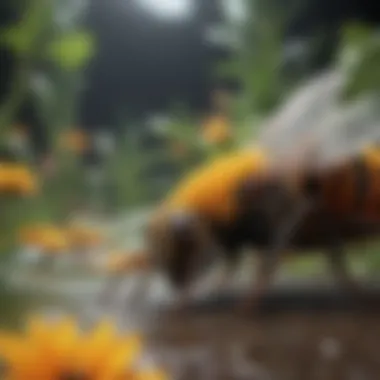

The Role of Nectar in Agricultural Systems
Nectar plays a critical role in agricultural systems, impacting both the growth of crops and the health of the surrounding ecosystem. While often overlooked, nectar's contribution to farming is profound, intertwining with pollination processes, plant diversity, and the overall functionality of agricultural practices.
Nectar-Providing Plants in Agriculture
Nectar-producing plants are essential in establishing and maintaining a healthy agricultural environment. Many crops, like sunflowers, clover, and alfalfa, generate nectar that attracts various pollinators. These plants not only fulfill agricultural requirements but also enhance the food chain within the ecosystem.
- Pollinator Support: Plants that provide nectar support various species of pollinators including bees, butterflies, and hummingbirds. An increased number of these creatures can lead to improved pollination efficiency, producing higher yields.
- Crop Diversity: Integrating nectar-rich plants into crop rotations can systematically boost biodiversity. This practice reduces pest pressure and improves soil health, contributing to the sustainability of farming practices.
Implications for Crop Pollination
Effective pollination is vital for crop production. Nectar's role in this context cannot be understated. It serves not only to attract pollinators but also to promote their activity. Proper management of nectar plants results in several benefits:
- Enhanced Crop Yields: Studies have shown that crops surrounded by nectar-rich plants receive more visits from pollinators, which significantly increases fruit and seed set.
- Quality Improvement: Increased pollination leads to better-quality produce, resulting in a more appealing market offering. This improves both revenue and consumer satisfaction.
Enhancing Biodiversity in Farms
Agriculture can often lead to biodiversity loss due to monoculture practices. However, incorporating nectar-producing plants can help mitigate this issue:
- Habitat Restoration: By providing food and habitats for pollinators, farmers can restore natural behaviors and populations. This can improve not only the farms but the surrounding environment as well.
- Resilience to Pests and Diseases: A diverse ecosystem can lead to natural pest control through healthy predator-prey dynamics. This reduces the need for chemical pesticides, promoting a healthier agricultural practice.
"Integrating nectar-rich plants into agricultural landscapes enhances not just crop production but the overall health of ecosystems."
In summary, understanding the role of nectar in agricultural systems offers valuable insight into improving farming practices. By strategically integrating nectar-producing plants, farmers can enhance pollination, improve crop yields, and foster a more resilient agricultural ecosystem.
Scientific Research on Nectar
The study of nectar, as a vital component of many ecological interactions, is crucial for understanding plant-pollinator dynamics and broader ecological frameworks. Scientific research on nectar provides insight into how plants attract specific pollinators, which in turn affects plant breeding systems and species distributions. Through diligent investigation, researchers uncover the biochemical properties of nectar and its implications on ecosystem health. These insights aim to inform conservation efforts, agricultural practices, and biodiversity management. Scientific research will clarify the important roles nectar plays beyond its appearance and sweetness.
Methodologies for Nectar Studies
To comprehend nectar's significance, various methodologies have been implemented in scientific studies. These methods include:
- Field Observations: Researchers conduct firsthand observations in natural settings to gather data on nectar secretion patterns, pollinator visitation rates, and plant responses.
- Laboratory Analysis: Nectar samples can be analyzed in controlled environments for their biochemical composition, including sugar concentration, amino acids, and secondary metabolites.
- Experimental Manipulations: Experiments are designed to test specific hypotheses, such as manipulating nectar availability to observe its effects on pollinator behavior.
- Molecular Techniques: Genetic analysis can reveal the underlying traits associated with nectar production, helping to elucidate how traits evolve in response to pollinator preferences.
Each methodology offers unique insights and has its strengths and limitations, which guide researchers in drawing informed conclusions about nectar's roles.
Findings in Ecology and Evolution
Research reveals that nectar is not just a food source but also a crucial factor in ecological and evolutionary processes. Some key findings include:
- Pollinator Preferences: Different species exhibit preferences for specific nectar compositions, which influences plant-pollinator co-evolution. This relationship often leads to adaptations in both plants and their associated pollinators over evolutionary time.
- Nectar Availability and Plant Fitness: Studies show that higher nectar production can enhance plant reproductive success through increased pollinator visits. This suggests that the quality and quantity of nectar directly impact seed production and population dynamics.
- Ecological Networks: Nectar serves as an important currency in the intricate web of plant-pollinator interactions, highlighting the dependence of various species on one another.
The findings underline nectar's multifaceted roles and contribute to the understanding of ecosystem functioning and biodiversity.
Case Studies on Specific Flora
Numerous case studies focus on specific plants and their nectar, providing deeper insights into unique interactions. For instance:
- Hyaloc syriaca: This plant's nectar composition is tailored to attract specific bee species, demonstrating how plants evolve traits to ensure effective pollination.
- Delphinium species: These flowers have been studied for their adaptive nectar traits that attract particular hummingbird species, showcasing how animals influence nectar evolution.
- Brassica rapa: Research into this agricultural plant has uncovered the implications of nectar on crop pollination efficiency, supporting sustainable farming practices.
Understanding these specific cases enhances our knowledge of biodiversity and showcases the importance of targeted research on nectar.
In examining case studies, we find that every plant plays a unique role in its ecosystem, influenced by its nectar characteristics. These inquiries lay the groundwork for future research, integrating knowledge of nectar's ecological importance with conservation strategies.
Factors Affecting Nectar Production
Understanding the factors that affect nectar production is crucial for comprehending the broader implications that nectar has on ecosystems and agriculture. Nectar serves as a vital resource for pollinators and influences plant reproductive success. Numerous elements can influence its quantity and quality, impacting the functioning of entire ecological systems.
Environmental Influences
Environmental factors play a significant role in nectar production. The availability of sunlight, temperature, and moisture directly affects how plants synthesize and secrete nectar.
- Sunlight: Plants require energy from sunlight for photosynthesis. Higher light intensity often leads to an increase in carbohydrate production, which translates into more nectar.
- Temperature: Temperature extremes can either enhance or inhibit nectar production. Generally, warmer temperatures during bloom periods encourage higher sugar concentrations in nectar, which attracts more pollinators. Conversely, frosty conditions may reduce production significantly.
- Soil Quality and Water Availability: The health of the soil influences plant vitality. Nutrient-rich soils and adequate water supply lead to vigorous plant growth, resulting in abundant nectar. Drought conditions stress plants, often leading to decreased nectar output.
Quote:
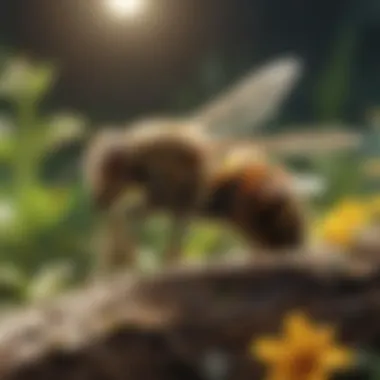

"The intricate balance of environmental conditions dictates not only the quantity but also the ecological dynamics of nectar availability."
Genetic Factors in Plants
Genetic makeup also contributes to the ability of individual plants to produce nectar. Different plant species have evolved various traits that affect nectar quantity and quality.
- Species Variation: Some species naturally produce more nectar than others. For instance, species like Monarda didyma are known for their high nectar yield, while others may have less to offer, depending on evolutionary adaptations.
- Selective Breeding: In agricultural contexts, selective breeding practices may enhance nectar production in crops such as clover and canola. By choosing plants with desirable traits, farmers can cultivate varieties that yield more nectar, benefiting both crops and pollinators.
Impact of Climate Change
Climate change presents significant challenges and opportunities for nectar production. With shifting climatic patterns, the production of nectar is becoming unpredictable.
- Altered Bloom Times: Changes in temperature and rainfall patterns can advance or delay flowering times. For example, warmer springs may lead to earlier blooming, which could misalign with the life cycles of pollinators, reducing effective pollination.
- Increased Stress: Extreme weather events can impose stress on nectar-producing plants. Heatwaves or prolonged droughts may reduce the overall health of the plants, leading to lower nectar levels. Additionally, species that cannot adapt quickly enough may face extinction, which has broader implications for entire ecosystems.
Understanding these factors is essential for conservation efforts and agriculture strategies. Given the intersection of nectar production with ecological balance, addressing these influences can lead to more sustainable practices in both natural and cultivated environments.
Nectar Harvesting and Utilization
Nectar harvesting plays an important role in how humans interact with plants and the ecosystem. It involves collecting the sugary liquid produced by flowers, which can be used in various ways, such as promoting agriculture, supporting pollinator populations, and even in culinary practices. Understanding the nuances of nectar harvesting is crucial for both ecological balance and economic benefits.
Cultural Practices in Harvesting
Different cultures have unique approaches to nectar harvesting. In some regions, people have practiced traditional methods that respect the natural lifecycle of flowering plants. For example, indigenous communities often harvest nectar from specific flowers while ensuring the sustainability of the plants.
- Timing: Harvesting is generally done at specific times of the day when nectar production is highest, often early morning or late afternoon.
- Technique: Many harvesters use gentle methods to extract nectar. This minimizes harm to the plants and allows them to continue producing nectar for pollinators.
- Ceremonies: Some cultures incorporate harvesting into rituals or celebrations. These practices encourage community engagement with local flora.
A careful balance is achieved when these cultural practices are done with respect for ecological integrity. Such practices not only serve the direct needs of people but also promote biodiversity by supporting healthy ecosystems.
Economic Significance of Nectar
Nectar has substantial economic implications, particularly in agriculture. It directly contributes to the production of honey and other nectar-derived products and indirectly supports crop yields.
- Honey Production: Beekeeping, or apiculture, is a major industry that relies on nectar from various plants. Honey produced can be sold in local and international markets, boosting rural economies.
- Crop Pollination: Many plants essential for food production require pollination to produce fruits and seeds. Nectar attracts pollinators such as bees, butterflies, and hummingbirds, enhancing pollination services and increasing yields.
- Market Trends: With growing consumer interest in natural and organic products, the demand for honey and by-products has risen. This trend supports local economies and promotes sustainable agricultural practices.
The economic significance of nectar cannot be overstated. By understanding and optimizing nectar production and utilization, farmers can enhance their profitability while promoting ecological health. This contributes to a sustainable food system and preserves biodiversity, essential for ecosystem resilience.
"Nectar harvesting, when done sustainably, creates a synergy between human needs and ecological responsibilities."
In summary, the cultural and economic aspects of nectar harvesting reveal its multifaceted importance in today’s world.
Challenges and Conservation Efforts
The relationship between nectar and pollinators is critical for maintaining ecological balance. However, various challenges have emerged that threaten both pollinator populations and the plants that rely on them for reproduction. This section discusses the multifaceted challenges facing nectar-producing flora and the consequential implications for biodiversity. It also explores conservation efforts aimed at addressing these threats to ensure the sustainability of ecosystems.
Threats to Pollinator Populations
Pollinator populations around the globe face numerous threats that endanger their survival. These include:
- Habitat Loss: Urbanization and agriculture lead to significant loss of natural habitats, disrupting the ecosystems where nectar-rich plants thrive.
- Pesticides: The use of chemicals in agriculture has detrimental effects on pollinators. Insecticides, for example, can be toxic to bees and other beneficial insects, impacting their ability to forage effectively.
- Climate Change: Shifts in climate patterns alter flowering times, which can desynchronize the availability of nectar with the needs of pollinators. This misalignment can harm both plants and their pollinators.
- Diseases and Parasites: Pathogens and parasites, such as Varroa mites in honeybee populations, pose additional challenges. These organisms can devastate bee colonies, reducing overall pollination capacity.
- Monoculture Practices: The extensive cultivation of a single crop reduces the diversity of nectar sources available to pollinators, meaning less food variety and quantity.
These threats are interlinked and exacerbate each other, creating a complex web of challenges that necessitate immediate attention from researchers, policymakers, and conservationists.
Conservation Strategies for Flora and Fauna
The conservation of nectar-producing plants must be approached through targeted strategies that address the underlying issues facing pollinators. Key strategies include:
- Creating Pollinator Habitats: Establishing wildflower strips or pollinator gardens within agricultural landscapes can provide essential forage and breeding grounds.
- Sustainable Agricultural Practices: Promoting integrated pest management and organic farming reduces pesticide use, protecting pollinator health.
- Research and Monitoring: Ongoing research into pollinator behavior and health can help identify stressors and effective interventions. Monitoring efforts enable tracking of population dynamics over time.
- Public Education and Engagement: Raising awareness about the importance of pollinators fosters community involvement in conservation efforts. Educational programs can motivate public action, such as reducing pesticide use in home gardens.
- Policy Support: Advocating for policies that protect habitats and promote biodiversity is crucial. Land-use regulations can prioritize the preservation of wild spaces where nectar plants flourish.
"Effective conservation strategies must incorporate ecological understanding and community involvement to reverse the decline of pollinators and secure our ecosystem's future."
By implementing these measures, it is possible to mitigate the challenges faced by nectar-related ecosystems. Conservation efforts must be collaborative, involving scientists, farmers, and community members working together to create a sustainable environment for both nectar and its vital contributors.
Epilogue
Nectar plays a pivotal role in the ecological web, making it essential to understand its importance. The multifaceted aspects of nectar—from its biochemical composition to its ecological roles—underscore its significance for both flora and fauna. This article has explored various elements, illustrating how nectar acts not only as a food source but also as a catalyst for biodiversity.
Summary of Nectar's Importance
In summary, nectar serves as an attractant for various pollinators, fostering essential plant-pollinator interactions. The sugars and amino acids found in nectar are vital for the nutritional needs of these organisms. Through these relationships, nectar contributes to plant reproductive success, leading to enhanced genetic diversity within ecosystems. It also supports various other fauna, thereby contributing to a balanced ecosystem. The implications for agriculture cannot be overlooked; by supporting pollinator health, nectar-producing plants enhance crop yields and biodiversity in agricultural systems.
Future Research Directions
Considering the challenges posed by climate change and habitat loss, further research is warranted to understand how nectar production may be affected. Studies that explore genetic variances among nectar-producing species could yield insights into how different plants respond to environmental changes. Additionally, researching how changing pollinator populations influence nectar dynamics would provide a clearer picture of ecosystem stability. Future studies should also aim to investigate the interplay between nectar composition and its effectiveness in attracting specific pollinators, which could inform conservation strategies and agricultural practices.


